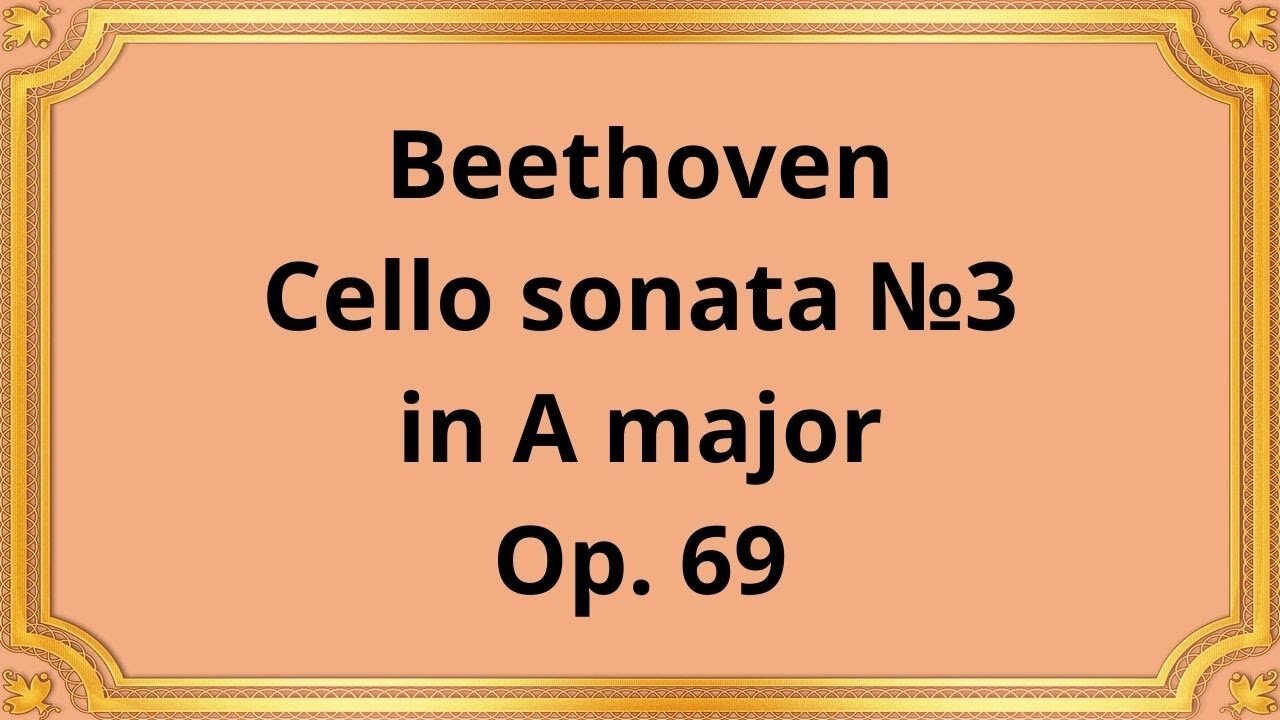Premium Only Content

Beethoven Cello sonata №3 in A major, Op. 69
#classical_music #Beethoven #Cello_sonata
Ludwig van Beethoven's Cello Sonata No. 3 in A major, Op. 69, is a masterful work that showcases the composer's unique and groundbreaking style. Composed in 1808, the Cello Sonata No. 3 is one of the most important works in the cello and piano repertoire, and it has been beloved by musicians and audiences alike for over two centuries.
The Cello Sonata No. 3 is comprised of four movements: Allegro ma non tanto, Scherzo - Allegro molto, Adagio cantabile, and Allegro vivace. The opening Allegro ma non tanto is a spirited and energetic movement, featuring a lively and virtuosic cello melody that is complemented by the piano. The Scherzo - Allegro molto that follows is a playful and whimsical movement, with a fast and intricate cello part that is accompanied by the piano. The Adagio cantabile is a slow and lyrical movement, featuring a soulful and expressive cello melody that is set against a delicate and understated piano accompaniment. The final Allegro vivace is a lively and triumphant movement, with a fast and virtuosic cello part that is supported by the piano.
One of the most striking features of the Cello Sonata No. 3 is the way in which Beethoven integrates the cello and piano parts. Rather than having the cello simply play a supporting role, as was often the case in classical music of the time, Beethoven creates a true duet between the two instruments. The cello and piano parts are interdependent, with each instrument contributing equally to the overall musical texture.
Another notable aspect of the Cello Sonata No. 3 is Beethoven's use of musical form. The piece follows a traditional sonata form, with an exposition, development, and recapitulation in the first movement. The second movement follows a more playful scherzo form, with a recurring theme that is interspersed with different episodes. The third movement is a slow and lyrical adagio, while the final movement is a fast and virtuosic rondo.
The Cello Sonata No. 3 is also notable for its emotional depth and intensity. Beethoven's use of complex harmonies and rhythms, as well as his skillful writing for the cello and piano, create a sense of drama and tension throughout the piece. The Adagio cantabile, in particular, is a deeply emotional and expressive movement that showcases Beethoven's mastery of musical emotion.
Overall, the Cello Sonata No. 3 in A major, Op. 69, is a groundbreaking work that showcases Beethoven's unique style and exceptional skill. Its integration of the cello and piano, use of musical form, and emotional depth have made it a beloved and enduring work in the cello and piano repertoire. The Cello Sonata No. 3 is a testament to Beethoven's enduring legacy as one of the greatest composers in the history of classical music.
You have the opportunity to support the channel
https://www.donationalerts.com/r/radsiaral
-
 14:44
14:44
Classical music_Music Inspiration
2 months agoLudwig van Beethoven Sonata No. 14 in C-Sharp Minor, Op. 27, No. 2 "Moonlight"
87 -
 2:05:15
2:05:15
Right Side Broadcasting Network
12 hours agoLIVE REPLAY: President Trump Attends UFC Fight 314 - 4/12/25
117K13 -
 2:07:42
2:07:42
BlackDiamondGunsandGear
11 hours agoWho’s in Town for This Stream?
64.6K4 -
 1:24:56
1:24:56
Quite Frankly
21 hours ago"Wild Tales: Crazy Story Hotline" | The Brothers Ep. 1
91.9K15 -
 12:37
12:37
Tundra Tactical
17 hours ago $6.30 earned🚫🚫 Biden Era GUN CONTROL Gone!!!! 🚫🚫
71.2K20 -
 1:00:09
1:00:09
Motherland Casino
10 hours ago $6.82 earnedCynthia X Mia
63K7 -
 5:32:47
5:32:47
BubbaSZN
16 hours ago🔴 LIVE - BUBBA PLAYS WARZONE SEASON 3
44.1K1 -
 2:29:26
2:29:26
Mally_Mouse
16 hours agoSaturday Shenanigans!! - Let's Play: REPO
60.4K14 -
 8:07
8:07
WhaddoYouMeme
1 day ago $5.17 earnedBut His Response Left Them Speechless!
45.9K55 -
 21:24
21:24
marcushouse
1 day ago $4.55 earnedStarship Launches Won’t Be the Same After This! 🔥
42.7K20